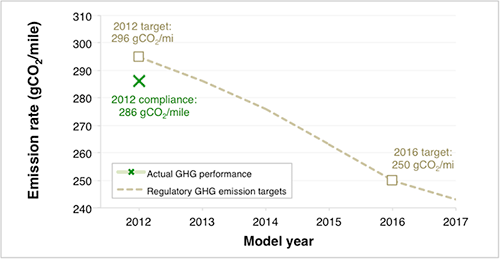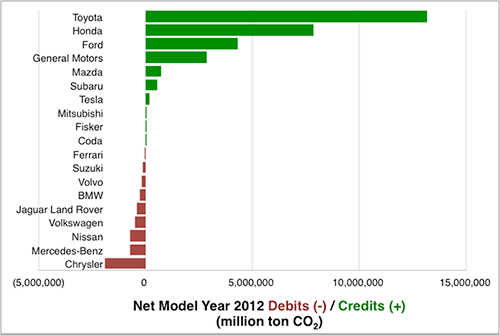Blog
Keep up the good work, automakers (and EPA)
There are lots of new high-efficiency models in the market: sedans, crossovers, pickups, and even sports cars. But how are the automakers doing, as a whole, in meeting federal US and California clean car standards? Pretty well, actually.
Last Friday, the US Environmental Projection Agency (EPA) released its first-ever “Manufacturer Performance Report” to summarize how automakers are reducing their products’ emissions to comply with greenhouse gas (GHG) emission standards. For context, the federal government produces a number of associated documents that highlight vehicle efficiency technology trends (i.e., in EPA’s “Trends” report), provide model-specific consumer info (i.e., Fuel Economy Guide), and give analogous NHTSA compliance reporting. This latest GHG compliance report is new and provides deeper analysis and transparency on the detailed regulatory provisions involved with automaker compliance. Here are a few quick reflections on the inaugural report.
First and foremost, the automakers, as a whole, stepped up. They stood with President Obama on 2012–2016 standards, and again on 2017–2025 standards, and now they’re meeting their obligations. In fact, technically the auto industry is beating their regulatory targets by a year – achieving 286 grams carbon dioxide emission per mile (gCO2/mi) in model year 2012. Their footprint-based standards only required 296 gCO2/mile, but they surpassed these by about 3.4%, essentially achieving the model year 2013 target a year early.
Average US model year 2012 compliance versus US EPA regulatory target for greenhouse gas emission rate for new light duty vehicles
Second, automaker compliance varied across the companies (see the figure below). The companies that generated the most overcompliance credits in 2012 are Toyota (with 13 million tons CO2, just from 2012), followed by Honda, Ford, and General Motors. On the other side, Chrysler, Mercedes, Nissan, and Volkswagen were the biggest deficit generators in 2012. Yet, these 2012-deficit companies have substantial pre-2012 early credits to utilize and keep a compliant balance sheet. Overall, credits earned by manufacturers from 2009 to 2011 are about an order of magnitude larger than the credits earned in 2012. It is likely that Hyundai and Kia (not shown) will also be significant credit generators; however their 2012 numbers are uncertain due to the need to correct errors in their vehicle testing data. Only one company, Jaguar Land-Rover, goes into 2013 with a deficit; they will need to over-comply in 2013-2015 and utilize the “carry-back” provisions, or they can purchase credits from another manufacturer to maintain compliance (or be subject to stiff fines).
Net model year 2012 debits and credits by auto company (without company-to-company trading or early credits)
Third, the EPA, with this report, does a superb job itemizing the various complex and detailed provisions. We find this especially important, considering the sophisticated regulation that includes footprint indexing, early credits, air-conditioning leakage and efficiency credits, off-cycle credits, advanced technology credits, N2O and CH4 crediting, carry-forward and carryback, transitional low-volume automaker allowances, flex-fuel (E85) vehicle crediting, car-to-truck trading, and company-to-company trading. This report makes it clear that EPA will diligently analyze and transparently report to the public how these regulatory provisions are working. As far as we know, there is no government internationally that has provided such detailed reporting on company-specific compliance. Our ICCT Europe Pocketbook attempts to provide this kind of information, and we continuously promote this sort of “full disclosure” on regulatory compliance to governments worldwide.
Lastly, it’s important to point out that beyond deploying lots of new powertrain, lightweighting, aerodynamic, and tire technologies, the non-efficiency provisions play an important role in company compliance. For example, companies are deploying new air-conditioning technologies at a faster rate than EPA had projected. Use of flexibilities for within-company trading (between “car” and “light truck” categories) and year-to-year transfers (carry-forward, carry-back) are commonplace. Among the flexibilities, the standards show a breakthrough in company-to-company credit trading activity, which has never been previously utilized. Ferrari acquired Honda credits, Chrysler acquired Nissan credits, and Mercedes acquired Nissan and Tesla credits. Also, credits for deployment of E85 flex fuel vehicles (even if they never utilize non-gasoline fuel) remain as an artifact of the original CAFE crediting through 2015. Finally, companies are starting to see special advanced technology credits, due to EPA’s incentives for electric vehicle deployment.
As our colleague at UCS points out, it’s only the first inning. But it’s looking like we’ve got a pretty good ballgame ahead of us.


